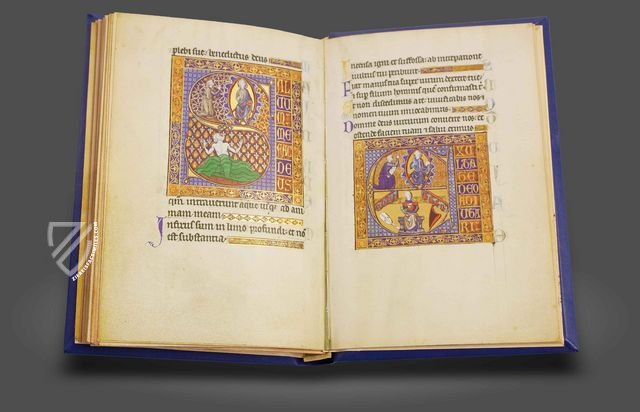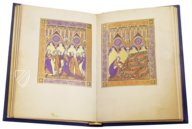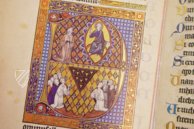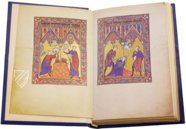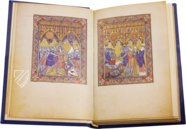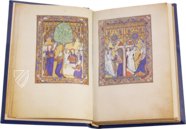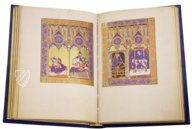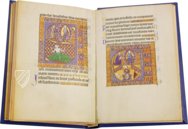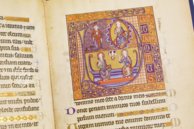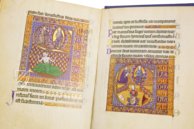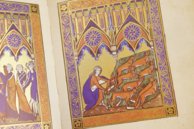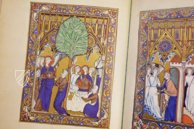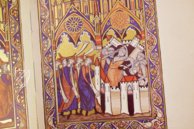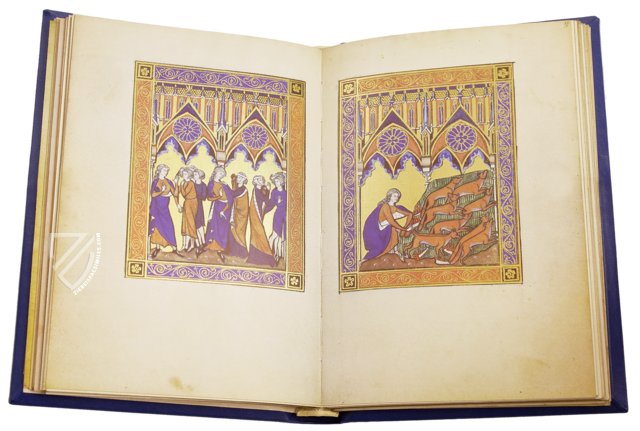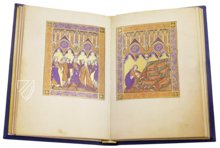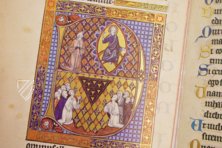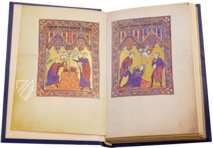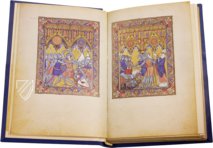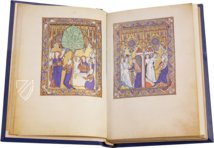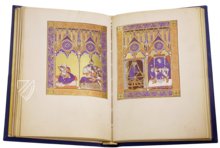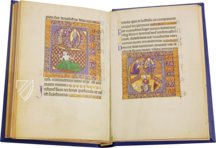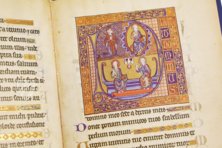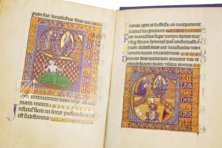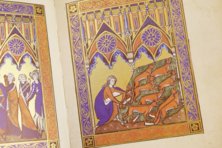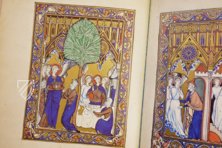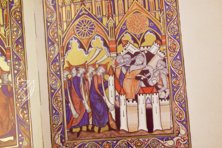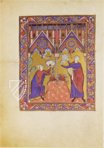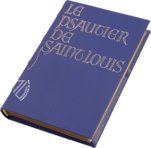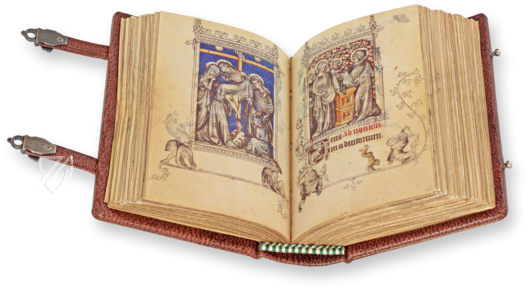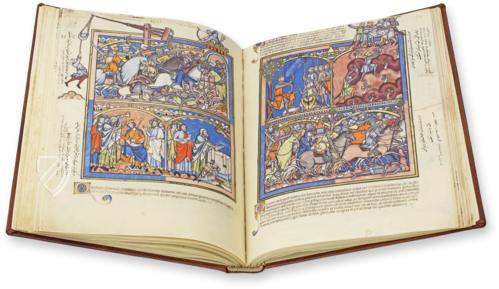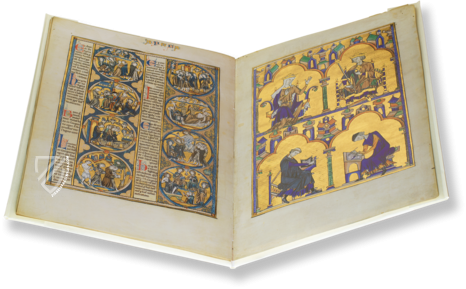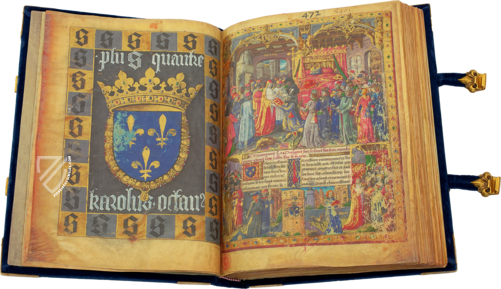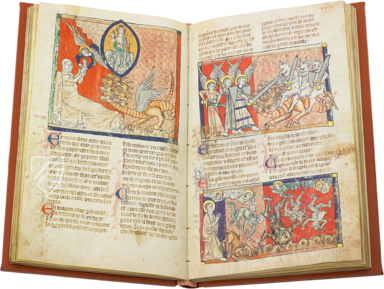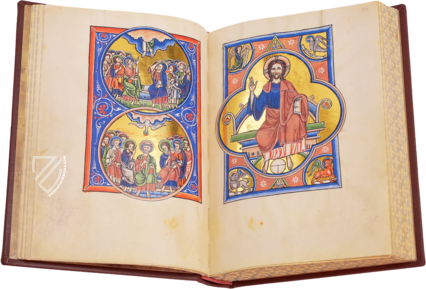Psalter of Louis the Saint
King Louis IX (1226–1270), also known as Louis the Saint, is the only canonized French monarch and is considered to be one of the most beloved kings of medieval France. Known as a reformer, especially to the justice system, his life was driven by a deep and sincere devotion to Christianity and Louis may have come closer to the ideal of a Christian king than any other. Louis was also a great patron of the arts,and commissioned, for example, some truly outstanding Gothic manuscripts. Among them is the so-called Psalter of Saint Louis, whose miniatures immediately bring to mind the impressive stained glass windows of the magnificent Sainte-Chapelle in Paris, also built at the behest of Louis the Saint. The 78 full-page miniatures of this precious manuscript are set against a sumptuously-burnished golden ground, thus lending the pictures an appearance of unequalled splendid glory. The figures are slender, graceful, and of a noble and elegant posture. This undoubtedly represents a highlight of Gothic illumination!
Psalter of Louis the Saint
Only a small number of manuscripts in the Bibliothèque Nationale may surpass the Psalter of Saint Louis in value and celebrity. Its value as one of the foremost artistic documents of French Gothic resides not only in the fact that it belonged to this French sovereign (1226–1270), whose great sense of justice and statesmanship were widely known, but also in the close relationship between its miniatures and the stained glass windows of the Sainte-Chapelle in Paris. This precious manuscript today holds 260 leaves, including 78 sumptuous full-page miniatures and eight magnificent figural initials. The miniatures literally illustrate diverse scenes of the Old Testament and undoubtedly represent a highlight of Gothic illumination. The text pages of the calendar and the Psalms in Latin perfectly match the pictorial decoration. They greatly contribute to the Psalter of Saint Louis, which is considered a masterpiece of book illumination, with their consistently executed calligraphy, elegantly balanced text layout, and rich decoration. Much like the stained glass windows in the Sainte-Chapelle, of which we are reminded in various aspects, the psalter not only constitutes a work of art but was mainly intended to provide a deeper understanding of the scriptures.
The Precious Miniatures
The biblical scenes are all depicted on a sumptuously-burnished golden ground, thus lending the pictures an appearance of unequalled splendid glory. The back of each miniature, painted on beautiful bright vellum, has been left blank to avoid the impairment of the pictures due to colors seeping through from the other side of the page. When opening the book, the beholder thus sees either two paired miniatures or two legends in French inscribed by a contemporary scribe on the verso side of each page. Although the manuscript seems to be the work of a team of illuminators, as was the case with most medieval manuscripts, it reflects great coherence. Most of the miniatures conform to the same design, the upper part being ornate with architectural motifs, a common feature of the early medieval tradition. The space below the architectural section is composed of two equally large oblong surfaces, usually representing Old Testament scenes. The figures are slender, graceful, and of a noble and elegant posture. They convey a feeling of harmony and movement, strangely contrasting with the seriousness and sometimes even the horror of the topics treated. Besides the deep blue and rose in the vestments of the depicted persons, one also finds light green, grey blue, and delicate tones of rose emerging timidly.
The Inventive Frames
All miniatures are set in frames. Some of them consist of big interlacing branches with trident leaves, their corners being filled with two intertwining dragons. Other frames are formed of alternately blue and red strips which are ornate with delicate golden foliage. Finally, some frames borrowed from Arab calligraphy, showing classical foliage combined with other, less frequently used motives.
A Saintly Picture Book
The tradition of combining Old Testament scenes with Davidian Psalms probably goes back to late antiquity, a tradition which was to be rediscovered by English scribes and Byzantine masters in the 12th or 13th century when the crusaders had established links between the West and the Christian Orient. In the 13th century there was a predilection for the depiction of biblical narratives, in the art of stained glass as well as in sculpture and illumination. It was the heyday of big didactic works which almost exclusively consisted of pictures, such as the Bible moralisée or the magnificent Bible of Saint Louis.
A King’s Prayer Book
We know with great certainty that Saint Louis was the owner of the psalter, which he had perhaps commissioned or even devised himself. We may be sure that the sovereign, whose biographers confirm that he read the Bible or other holy texts every day, was perfectly able to recognize and appreciate the depictions of the Old Testament. After the death of Saint Louis, his psalter passed through several noble hands and finally ended up in the National Library in Paris. It was a highly venerated gift on each occasion.
Codicology
- Alternative Titles
- Psautier de Saint Louis
Salterio di San Luigi
Psalter Ludwigs des Heiligen
Psautier dit de saint Louis
Psalter of Louis IX - Size / Format
- 520 pages / 21.0 × 14.5 cm
- Origin
- France
- Date
- 1260–1270
- Style
- Genre
- Script
- Gothic Textura Quadrata
- Illustrations
- 78 full-page miniatures, 8 large historiated initials, and numerous smaller decorative initials
- Content
- Psalter - use of Paris, litrugical calendar, canticles
- Patron
- King Louis IX aka Louis the Saint (1214–70)
- Previous Owners
- Jeanne d'Evreux (1310–71)
Charles V (1338–80)
Charles VI (1368–1422)
Marie of Valois, Prioress of Poissy (1393–1438)
Count Alexis Golovkin (1765-1811)
Prince Mikhail Petrovich Golitzin (1764–1835)
Louis XVIII (1755–1824)
Psalter of Louis the Saint
Beatus Vir
This splendid historiated initial with two faces wrapped in acanthus leaves introduces the first words of the Book of Psalms, “Blessed is the man”. In the upper register, David looks out the window of a Gothic palace at the naked Bathsheba. Her impregnation and the subsequent scheme to have her husband killed by placing him in the first line of battle are omitted. Instead, the lower register “fast-forwards” to David repenting on his knees in front of a background patterned with fleurs-de-lys to God, who is enthroned in a mandorla holding a globe with a “T-O” map in one hand and making the sign of benediction with the other.
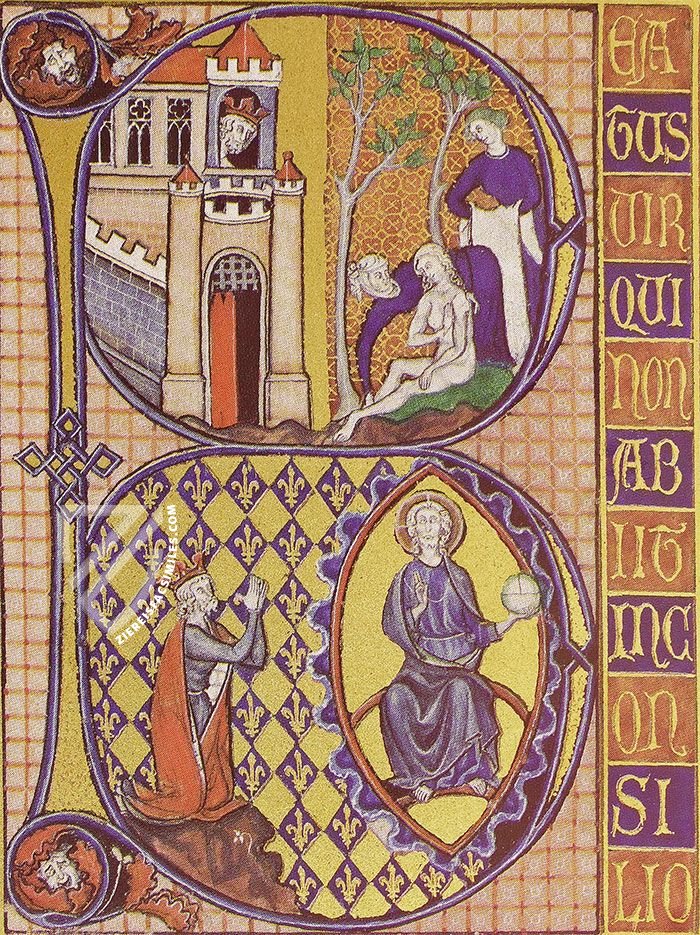
Psalter of Louis the Saint
The Victory of Abraham over the Four Kings
In a rarely depicted scene from Genesis 14, Abraham leads 318 trained servants from his household in a raid against their enemies, an alliance of the four Mesopotamian kings Kedorlaomer, Tidal, Amraphel, and Arioch. They free Lot and other captives, recover their looted goods, and completely route the enemy, whose camp is represented by two white tents. The scene, like the rest of the 78 full-page miniatures, plays out beneath a Gothic architecture.
Three of the four kings lie dead in a heap as Abraham, dressed in red with a white beard, raises his sword to slay the fourth king. His shield has a dragon escutcheon in contrast to the fleurs-de-lys of Abraham’s shield – one of numerous allusions to a connection between the French royal house and various prominent biblical figures. An additional four pairs of dragons are depicted with intertwined necks in the corners of the decorative frame.
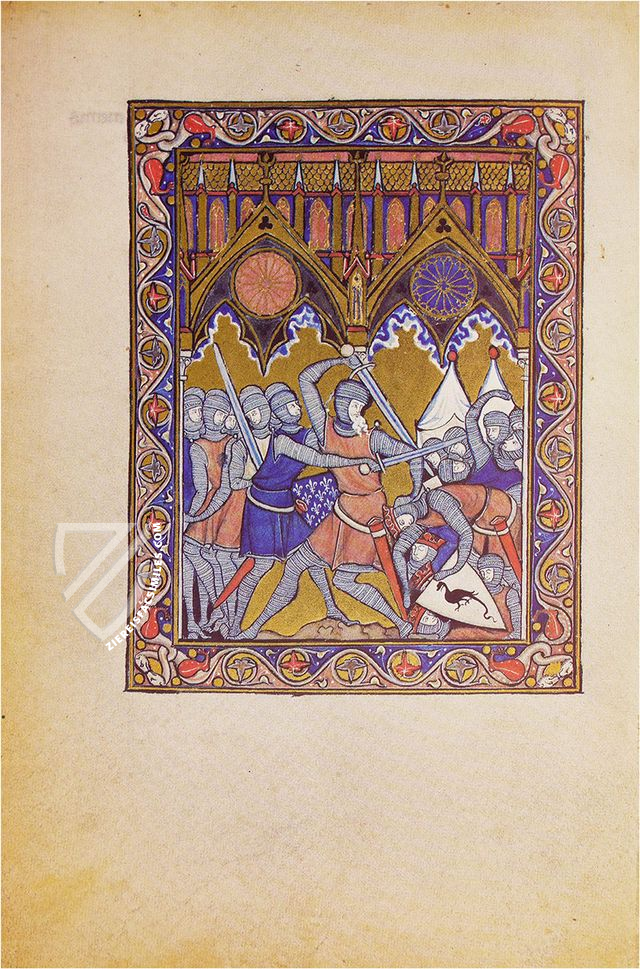
#1 Psautier de Saint Louis
Language: English
- Treatises / Secular Books
- Apocalypses / Beatus
- Astronomy / Astrology
- Bestiaries
- Bibles / Gospels
- Chronicles / History / Law
- Geography / Maps
- Saints' Lives
- Islam / Oriental
- Judaism / Hebrew
- Single Leaf Collections
- Leonardo da Vinci
- Literature / Poetry
- Liturgical Manuscripts
- Medicine / Botany / Alchemy
- Music
- Mythology / Prophecies
- Psalters
- Other Religious Books
- Games / Hunting
- Private Devotion Books
- Other Genres
- Afghanistan
- Armenia
- Austria
- Belgium
- Belize
- Bosnia and Herzegovina
- China
- Colombia
- Costa Rica
- Croatia
- Cyprus
- Czech Republic
- Denmark
- Egypt
- El Salvador
- Ethiopia
- France
- Germany
- Greece
- Guatemala
- Honduras
- Hungary
- India
- Iran
- Iraq
- Israel
- Italy
- Japan
- Jordan
- Kazakhstan
- Kyrgyzstan
- Lebanon
- Liechtenstein
- Luxembourg
- Mexico
- Morocco
- Netherlands
- Palestine
- Panama
- Peru
- Poland
- Portugal
- Romania
- Russia
- Serbia
- Spain
- Sri Lanka
- Sweden
- Switzerland
- Syria
- Tajikistan
- Turkey
- Turkmenistan
- Ukraine
- United Kingdom
- United States
- Uzbekistan
- Vatican City
- A. Oosthoek, van Holkema & Warendorf
- Aboca Museum
- Ajuntament de Valencia
- Akademie Verlag
- Akademische Druck- u. Verlagsanstalt (ADEVA)
- Aldo Ausilio Editore - Bottega d’Erasmo
- Alecto Historical Editions
- Alkuin Verlag
- Almqvist & Wiksell
- Amilcare Pizzi
- Andreas & Andreas Verlagsbuchhandlung
- Archa 90
- Archiv Verlag
- Archivi Edizioni
- Arnold Verlag
- ARS
- Ars Magna
- ArtCodex
- AyN Ediciones
- Azimuth Editions
- Badenia Verlag
- Bärenreiter-Verlag
- Belser Verlag
- Belser Verlag / WK Wertkontor
- Benziger Verlag
- Bernardinum Wydawnictwo
- BiblioGemma
- Biblioteca Apostolica Vaticana (Vaticanstadt, Vaticanstadt)
- Bibliotheca Palatina Faksimile Verlag
- Bibliotheca Rara
- Boydell & Brewer
- Bramante Edizioni
- Bredius Genootschap
- Brepols Publishers
- British Library
- C. Weckesser
- Caixa Catalunya
- Canesi
- CAPSA, Ars Scriptoria
- Caratzas Brothers, Publishers
- Carus Verlag
- Casamassima Libri
- Centrum Cartographie Verlag GmbH
- Chavane Verlag
- Christian Brandstätter Verlag
- Circulo Cientifico
- Club Bibliófilo Versol
- Club du Livre
- CM Editores
- Collegium Graphicum
- Collezione Apocrifa Da Vinci
- Comissão Nacional para as Comemorações dos Descobrimentos Portugueses
- Coron Verlag
- Corvina
- CTHS
- D. S. Brewer
- Damon
- De Agostini/UTET
- De Nederlandsche Boekhandel
- De Schutter
- Deuschle & Stemmle
- Deutscher Verlag für Kunstwissenschaft
- DIAMM
- Droz
- E. Schreiber Graphische Kunstanstalten
- Ediciones Boreal
- Ediciones Grial
- Ediclube
- Edições Inapa
- Edilan
- Editalia
- Edition Deuschle
- Edition Georg Popp
- Edition Leipzig
- Edition Libri Illustri
- Editiones Reales Sitios S. L.
- Éditions de l'Oiseau Lyre
- Editions Medicina Rara
- Editorial Casariego
- Editorial Mintzoa
- Editrice Antenore
- Editrice Velar
- Edizioni Edison
- Egeria, S.L.
- Eikon Editores
- Electa
- Emery Walker Limited
- Enciclopèdia Catalana
- Eos-Verlag
- Ephesus Publishing
- Ernst Battenberg
- Eugrammia Press
- Extraordinary Editions
- Fackelverlag
- Facsimila Art & Edition
- Facsimile Editions Ltd.
- Facsimilia Art & Edition Ebert KG
- Faksimile Verlag
- Feuermann Verlag
- Folger Shakespeare Library
- Franco Cosimo Panini Editore
- Friedrich Wittig Verlag
- Fundación Hullera Vasco-Leonesa
- G. Braziller
- Gabriele Mazzotta Editore
- Gebr. Mann Verlag
- Gesellschaft für graphische Industrie
- Getty Research Institute
- Giovanni Domenico de Rossi
- Giunti Editore
- Graffiti
- Grafica European Center of Fine Arts
- Guido Pressler
- Guillermo Blazquez
- Gustav Kiepenheuer
- H. N. Abrams
- Harrassowitz
- Harvard University Press
- Helikon
- Hendrickson Publishers
- Henning Oppermann
- Herder Verlag
- Hes & De Graaf Publishers
- Hoepli
- Holbein-Verlag
- Houghton Library
- Hugo Schmidt Verlag
- Idion Verlag
- Il Bulino, edizioni d'arte
- ILte
- Imago
- Insel Verlag
- Insel-Verlag Anton Kippenberger
- Instituto de Estudios Altoaragoneses
- Instituto Nacional de Antropología e Historia
- Istituto dell'Enciclopedia Italiana - Treccani
- Istituto Ellenico di Studi Bizantini e Postbizantini
- Istituto Geografico De Agostini
- Istituto Poligrafico e Zecca dello Stato
- Italarte Art Establishments
- Jan Thorbecke Verlag
- Johnson Reprint Corporation
- Josef Stocker
- Josef Stocker-Schmid
- Jugoslavija
- Karl W. Hiersemann
- Kasper Straube
- Kaydeda Ediciones
- Kindler Verlag / Coron Verlag
- Kodansha International Ltd.
- Konrad Kölbl Verlag
- Kurt Wolff Verlag
- La Liberia dello Stato
- La Linea Editrice
- La Meta Editore
- Lambert Schneider
- Landeskreditbank Baden-Württemberg
- Leo S. Olschki
- Les Incunables
- Liber Artis
- Library of Congress
- Libreria Musicale Italiana
- Lichtdruck
- Lito Immagine Editore
- Lumen Artis
- Lund Humphries
- M. Moleiro Editor
- Maison des Sciences de l'homme et de la société de Poitiers
- Manuscriptum
- Martinus Nijhoff
- Maruzen-Yushodo Co. Ltd.
- MASA
- Massada Publishers
- McGraw-Hill
- Metropolitan Museum of Art
- Militos
- Millennium Liber
- Müller & Schindler
- Nahar - Stavit
- Nahar and Steimatzky
- National Library of Wales
- Neri Pozza
- Nova Charta
- Oceanum Verlag
- Odeon
- Orbis Mediaevalis
- Orbis Pictus
- Österreichische Staatsdruckerei
- Oxford University Press
- Pageant Books
- Parzellers Buchverlag
- Patrimonio Ediciones
- Pattloch Verlag
- PIAF
- Pieper Verlag
- Plon-Nourrit et cie
- Poligrafiche Bolis
- Presses Universitaires de Strasbourg
- Prestel Verlag
- Princeton University Press
- Prisma Verlag
- Priuli & Verlucca, editori
- Pro Sport Verlag
- Propyläen Verlag
- Pytheas Books
- Quaternio Verlag Luzern
- Reales Sitios
- Recht-Verlag
- Reichert Verlag
- Reichsdruckerei
- Reprint Verlag
- Riehn & Reusch
- Roberto Vattori Editore
- Rosenkilde and Bagger
- Roxburghe Club
- Salerno Editrice
- Saltellus Press
- Sandoz
- Sarajevo Svjetlost
- Schöck ArtPrint Kft.
- Schulsinger Brothers
- Scolar Press
- Scrinium
- Scripta Maneant
- Scriptorium
- Shazar
- Siloé, arte y bibliofilia
- SISMEL - Edizioni del Galluzzo
- Sociedad Mexicana de Antropología
- Société des Bibliophiles & Iconophiles de Belgique
- Soncin Publishing
- Sorli Ediciones
- Stainer and Bell
- Studer
- Styria Verlag
- Sumptibus Pragopress
- Szegedi Tudomànyegyetem
- Taberna Libraria
- Tarshish Books
- Taschen
- Tempus Libri
- Testimonio Compañía Editorial
- Thames and Hudson
- The Clear Vue Publishing Partnership Limited
- The Facsimile Codex
- The Folio Society
- The Marquess of Normanby
- The Richard III and Yorkist History Trust
- Tip.Le.Co
- TouchArt
- TREC Publishing House
- TRI Publishing Co.
- Trident Editore
- Tuliba Collection
- Typis Regiae Officinae Polygraphicae
- Union Verlag Berlin
- Universidad de Granada
- University of California Press
- University of Chicago Press
- Urs Graf
- Vallecchi
- Van Wijnen
- VCH, Acta Humaniora
- VDI Verlag
- VEB Deutscher Verlag für Musik
- Verlag Anton Pustet / Andreas Verlag
- Verlag Bibliophile Drucke Josef Stocker
- Verlag der Münchner Drucke
- Verlag für Regionalgeschichte
- Verlag Styria
- Vicent Garcia Editores
- W. Turnowski Ltd.
- W. Turnowsky
- Waanders Printers
- Wiener Mechitharisten-Congregation (Wien, Österreich)
- Wissenschaftliche Buchgesellschaft
- Wissenschaftliche Verlagsgesellschaft
- Wydawnictwo Dolnoslaskie
- Xuntanza Editorial
- Zakład Narodowy
- Zollikofer AG

